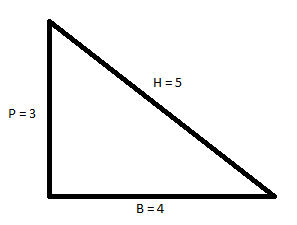
How do you calculate $\cos \left( {{{\tan }^{ - 1}}\left( {\dfrac{3}{4}} \right)} \right)$ ?
Answer
542.1k+ views
Hint: Here the basic concept which is going to be used is that we can convert arctan into arccos. So, firstly we will convert the value ${\tan ^{ - 1}}\left( {\dfrac{3}{4}} \right)$ into arccos and then we will just adjust the value, that was left behind, with cosine.
Complete Step by Step Solution:
We have to find the value of $\cos \left( {{{\tan }^{ - 1}}\left( {\dfrac{3}{4}} \right)} \right)$
So, now let us consider ${\tan ^{ - 1}}\left( {\dfrac{3}{4}} \right)$ as $\theta $
$ \Rightarrow {\tan ^{ - 1}}\left( {\dfrac{3}{4}} \right) = \theta $ ……(i)
Now, we will multiply both sides by tan, then we will get
$ \Rightarrow \tan \left( {{{\tan }^{ - 1}}\left( {\dfrac{3}{4}} \right)} \right) = \tan \theta $
Now, we will adjust tan with ${\tan ^{ - 1}}$ on the left side, then we will get
$ \Rightarrow \tan \theta = \dfrac{3}{4}$
As we know that $\tan \theta = \dfrac{P}{B}$, where P is perpendicular and B is the base of a right angle triangle
Let us take hypotenuse as H. Now we will apply Pythagoras theorem i.e. ${H^2} = {P^2} + {B^2}$
Here P and B are 3 and 4 respectively
So, ${H^2} = {P^2} + {B^2}$
$ \Rightarrow {H^2} = {3^2} + {4^2}$
On further simplification,
$ \Rightarrow {H^2} = 9 + 16$
$ \Rightarrow {H^2} = 25$
Now, take the square root of both sides
$\Rightarrow \sqrt{{{H}^{2}}}=\sqrt{25}$
$ \Rightarrow H = 5$

Now, as we know that $\cos \theta = \dfrac{B}{H}$
Therefore, $\cos \theta = \dfrac{4}{5}$
From (i), we can see that $\theta = {\tan ^{ - 1}}\left( {\dfrac{3}{4}} \right)$
Hence, $\cos \left( {{{\tan }^{ - 1}}\left( {\dfrac{3}{4}} \right)} \right) = \dfrac{4}{5}$
$ \Rightarrow \cos \left( {{{\tan }^{ - 1}}\left( {\dfrac{3}{4}} \right)} \right) = 0.8$
Note:
It will be suggested to you that whenever you are doing these types of questions, just simply make a right angle triangle. Mark hypotenuse, perpendicular, and base on it and write the value in front of it so that you will not make any kind of mistake. And one more thing, take care that the trigonometric function is the ratio of perpendicular and hypotenuse, base and hypotenuse, perpendicular and base.
Complete Step by Step Solution:
We have to find the value of $\cos \left( {{{\tan }^{ - 1}}\left( {\dfrac{3}{4}} \right)} \right)$
So, now let us consider ${\tan ^{ - 1}}\left( {\dfrac{3}{4}} \right)$ as $\theta $
$ \Rightarrow {\tan ^{ - 1}}\left( {\dfrac{3}{4}} \right) = \theta $ ……(i)
Now, we will multiply both sides by tan, then we will get
$ \Rightarrow \tan \left( {{{\tan }^{ - 1}}\left( {\dfrac{3}{4}} \right)} \right) = \tan \theta $
Now, we will adjust tan with ${\tan ^{ - 1}}$ on the left side, then we will get
$ \Rightarrow \tan \theta = \dfrac{3}{4}$
As we know that $\tan \theta = \dfrac{P}{B}$, where P is perpendicular and B is the base of a right angle triangle
Let us take hypotenuse as H. Now we will apply Pythagoras theorem i.e. ${H^2} = {P^2} + {B^2}$
Here P and B are 3 and 4 respectively
So, ${H^2} = {P^2} + {B^2}$
$ \Rightarrow {H^2} = {3^2} + {4^2}$
On further simplification,
$ \Rightarrow {H^2} = 9 + 16$
$ \Rightarrow {H^2} = 25$
Now, take the square root of both sides
$\Rightarrow \sqrt{{{H}^{2}}}=\sqrt{25}$
$ \Rightarrow H = 5$

Now, as we know that $\cos \theta = \dfrac{B}{H}$
Therefore, $\cos \theta = \dfrac{4}{5}$
From (i), we can see that $\theta = {\tan ^{ - 1}}\left( {\dfrac{3}{4}} \right)$
Hence, $\cos \left( {{{\tan }^{ - 1}}\left( {\dfrac{3}{4}} \right)} \right) = \dfrac{4}{5}$
$ \Rightarrow \cos \left( {{{\tan }^{ - 1}}\left( {\dfrac{3}{4}} \right)} \right) = 0.8$
Note:
It will be suggested to you that whenever you are doing these types of questions, just simply make a right angle triangle. Mark hypotenuse, perpendicular, and base on it and write the value in front of it so that you will not make any kind of mistake. And one more thing, take care that the trigonometric function is the ratio of perpendicular and hypotenuse, base and hypotenuse, perpendicular and base.
Recently Updated Pages
Why are manures considered better than fertilizers class 11 biology CBSE

Find the coordinates of the midpoint of the line segment class 11 maths CBSE

Distinguish between static friction limiting friction class 11 physics CBSE

The Chairman of the constituent Assembly was A Jawaharlal class 11 social science CBSE

The first National Commission on Labour NCL submitted class 11 social science CBSE

Number of all subshell of n + l 7 is A 4 B 5 C 6 D class 11 chemistry CBSE

Trending doubts
What is meant by exothermic and endothermic reactions class 11 chemistry CBSE

10 examples of friction in our daily life

One Metric ton is equal to kg A 10000 B 1000 C 100 class 11 physics CBSE

1 Quintal is equal to a 110 kg b 10 kg c 100kg d 1000 class 11 physics CBSE

Difference Between Prokaryotic Cells and Eukaryotic Cells

What are Quantum numbers Explain the quantum number class 11 chemistry CBSE




